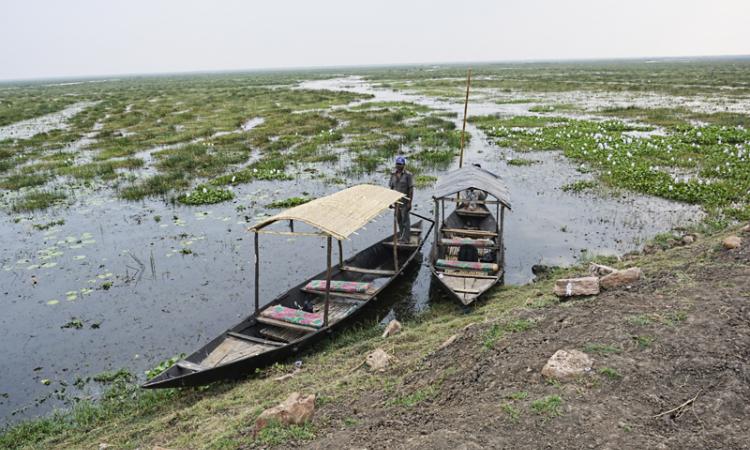
Nature and wildlife can be better conserved if local communities are duly educated and motivated. Nearly 70 km south of Bhubaneswar, the Mangalajodi village on the edge of Chilka lake, Asia’s largest brackish water lagoon, is a testimony to that argument.
About 25 villagers, many of whom were once-known bird poachers, have now become saviours of the avian winter guests coming in from different parts of the globe including the Siberian and Arabian countries.
Birds are drawn to Chilka's
The swampy edge of Chilka near Mangalajodi receives approximately 1.5 lakh birds every winter. Experts believe that the reason for this is its huge as well as diverse fishery resources and a unique eco-system comprising varieties of aquatic plant species, which together make Chilka the place of ample food opportunities for its winged visitors. The lake received about 9 lakh migratory birds in 2013 while the number was less last season possibly because of the impact of the cyclonic storm Phailin that hit the Odisha coast in October 2013.
A report published in Current Science based on a study conducted by the Indian National Centre for Ocean Information Services (INCOIS), Phailin has altered the concentration of salinity, silicate and ammonia, which may lead to an alteration in the composition of the phytoplankton species and may also affect the “food web” and the “lagoon's economy".
Sri Sri Mahaveer Pakshi Suraksha Samiti is formed
Motivated by Nandakishore Bhujabal, a nature and wildlife lover who founded the NGO Wild Orissa, villagers of Mangalajodi formed a bird protection committee named Sri Sri Mahaveer Pakshi Suraksha Samiti in 2000. “The committee members look after the protection of migratory birds and make some income by taking tourists into the lake for a closer view of the birds,” says Ramahari Behera, President of the Samiti.
With support from Wild Orissa, they started out with only three boats. Then, the Samiti added one more while members have added eight of their personal boats to bring up the total to 12 boats. “During the three months when the birds are in this part of the lake, each member earns about Rs. 5000 per month by carrying tourists into the lake,” says Madhav Behera, Secretary of the Samiti.
“This income is not enough to run the family but there is no alternative we can think about,” adds Madhav.
Income source taken away
Traditionally, people living around Chilka Lake have depended on the lagoon and its fishery resources that comprises about 225 varieties of fish. Per data provided by the Chilka Development Authority (CDA), “Chilika Lake has 132 fishing villages with a total population of more than 0.15 million,” of which “about 30% (46,500) are active fishermen, although many others depend indirectly on fisheries”.
Mentioning that the lake provides livelihood to about 2,00,000 fishermen living in surrounding villages, a report published in the Fishing Chimes says that “The fisheries output shares more than 70% of Chilka’s economic value with a fish catch composition that includes fish (65%), shrimp (33%) and crab (2%)”. Sadly, fishing which was the primary source of livelihood for centuries earning fishermen as much as Rs. 300 - 500 per day, has not remained reliable for the villagers of Mangalajodi as overfishing and shrinking of the lake have made it difficult for the local fishing folks to get a good catch.
Shrinking lake, shrinking revenue
Though official data provided by the Odisha government says that the lagoon is spread over 1100 sq. km and 1165 sq. km as per the CDA, the report on Phailin impact on Chilka Lake, published in Current Science, indicates that the area has come down to 1020 sq. km during monsoons and 704 sq. km during the summer.
Villagers say that the lake, which was once close to the village, is now 3 km away. “Again as the edge has become swampy, we need to go 5 km further into the lake for fishing. Even then, we hardly get a good-size fish in Chilka these days,” says a local fisherman.
A standard catch makes 5-7 kg of fish on average and fetches between Rs. 300-500 per day per fisherman apart from meeting his own consumption needs. However, this is possible only when one gets good-sized fish each weighing over 1 kg because such sized fishes are in great demand in the market. This hardly happens nowadays.
As the daily catch has not remained as alluring as before, the youth of the village have begun migrating. “About 90% of the youth is migrating to other states to work as wage labourer,” said Jadu Behera, vice-president of the Samiti.
In order to keep the community engaged in conserving the lake and its ecosystem, it is essential that alternate livelihood options be offered to these villagers. Unfortunately, "nobody bothers for us. Neither the union of fishing folk in the area nor the government understand our problems and try to resolve them. Everyone rather plays with the poor people only”, Madhav says with grief.
/articles/poachers-turned-protectors-fight-their-survival